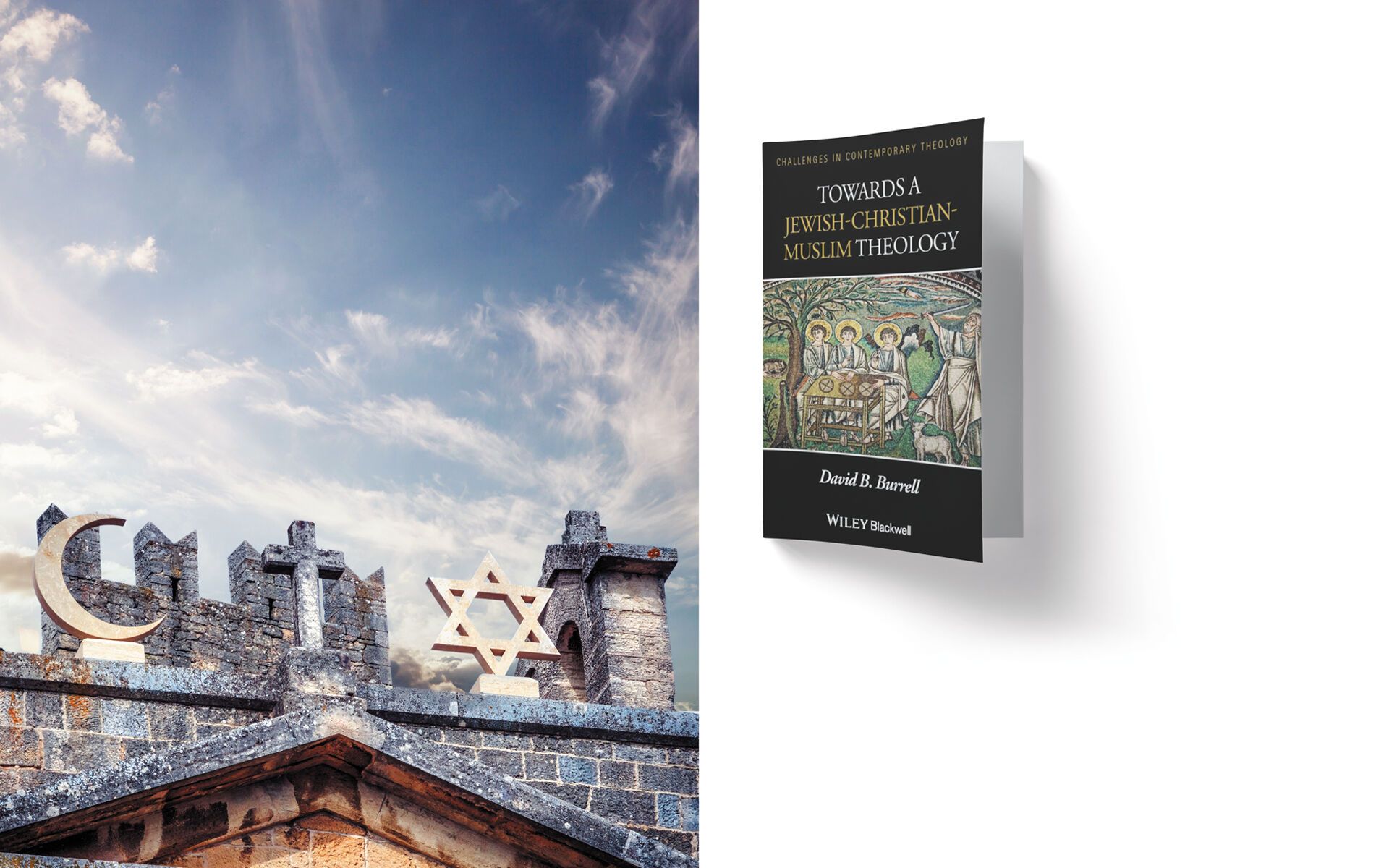Towards a Jewish-Christian-Muslim Theology

In This Article
-
Burrell’s book exercises what he calls “creative hermeneutics”: he explores illuminative “similarities-in-differences” within conceptual patterns developed by each tradition.
-
It is the life and deeds of the notable figures of faith that allow us to ground our “frame of reference” or “benchmarks” as to what a systematic doctrine can be when it is “embodied” in real life.
-
De Caussade’s discourse offers a “remarkable parallel” to Ghazali’s: faith, while outstripping conceptualization, is confirmed in an inexhaustible trust that divine action “operates in each moment and in all things.”
The liberating document of Vatican Council II, Nostra Aetate, stirred up an enormous interest in interfaith inquiry. One of the distinctive modern Catholic voices belongs to David Burrell (b. 1933), a philosophic theologian and Professor Emeritus at Moreau Seminary, Notre Dame, Indiana. His book, Towards a Jewish-Christian-Muslim Theology (Chichester: Wiley-Blackwell, 2011), seeks to contribute to the young and yet ever-growing field of comparative theology. Boldly attempting to compare such loaded theological terms as creation, freedom of will, and grace, as exposed by leading medieval and modern thinkers in each Abrahamic tradition, Burrell’s book exercises what he calls “creative hermeneutics”: he explores illuminative “similarities-in-differences” within conceptual patterns developed by each tradition (xxii). Indeed, for Burrell, Jews, Christians, and Muslims “all worship the same God” (xi), each tradition elaborating the features of the divine in a remarkable parallelism. Methodologically speaking, Burrell espouses the post liberal Lutheran theologian George Lindbeck’s emphasis on the primacy of the believers’ praxis over their doctrines, considering the latter as “precipitations” or “distillations” of the former (1). Burrell also recognizes that the “tone” for his project was set by the famous Catholic theologian Bernard Lonergan’s “sense for the intellectual developments latent in a revelational tradition” and his invitation to grasp theological questions that undergird any doctrinal answers (xiv).
In Chapter 1, “Free Creation as a Shared Task for Jews, Christians, Muslims,” Burrell shows how each tradition helped shape the overall context in which the doctrine of creation was elaborated (11). Each, for instance, shared the belief—as unimaginable it is—that “creation can only be creation if God can be without creating” (i.e., can exist without the world) (11, 13). Burrell also mentions Ghazali, Maimonides, and Aquinas as thinkers who resemble each other in envisaging revelation as a corrective to the once-popular Neo-Platonic idea that Creation “emanates” from God of its own accord. At one place, however, it seems that Burrell reads into Aquinas something that neither Aquinas himself nor such neo-Thomists as J. Maritan or B. Lonergan would accept: Aquinas, despite all his endorsement for the idea of existence as a divine “act” rather than “substance,” can hardly be seen “dismissive” of the idea that God is “perfect” (21).
The next chapter, “Relating Divine Freedom with Human Freedom,” shows how resourceful Islamic and Christian traditions can be when it comes to a “zero-sum” game between the freedom of humans and their autonomous volition vis-à-vis the omnipotence of the divine as signifying Creation’s total subordination. Ghazali, for instance, points out that the issue outstrips human conceptualizing altogether, emphasizing instead the importance of one’s spiritual state (as opposed to knowledge) as one’s habitual capacity to align one’s personal responses to various events with one’s realization of divine omnipresence and omnipotence (35-6). Burrell is also beholden to Aquinas’ account of the “free gift” of divine grace—the latter equips one’s will with an inbuilt orientation and an initial “specification” toward “comprehensive good” and yet never predetermines the outcome of our choices; humans are thought of as “free creators” of their actions only when they deny the gift (37, 40). Burrell speaks of the notion of “situated freedom”—admittedly rhetorical as it is—as a stance implicitly affirmed by mainstream Christian and Muslim theologians. According to it, even if countless moral, political, social, economic, and other compulsions (“pushes”) and attractions (“pulls”) constantly inform the warp and weft of one’s life, there is still a room for one’s personal discretion and preference (37, 45).
Chapter 3, “Human Initiative and Divine Grace,” demonstrates how each tradition conceives of the divine not as the “biggest thing around” (which would be tantamount to idolatry) but rather as a “non-duality” in which the effect (Creation) can subsist in a way that detracts nothing from the ontological primacy of the cause (God). Far from being a remote “deistic god,” this divine is both self-same with Creation (58-60) and “interpersonally” related with Creation, be this relation expressed through “grace” (Christians), “covenant” (Jews), or “proximity to God” (Muslims) (51-53). Burrell, however, does not show if, and how, this “non-duality” can be defended against the possible accusation of monism or pantheism.
Chapter 4, “Trust in Divine Providence,” further expands—admittedly, rather rhetorically than demonstratively—on the intractable issue of the freedom of humans vis-à-vis God’s omnipotence and generosity, this time comparing the following two “key works in Christianity and Islam”: the Jesuit priest and professor Jean-Pierre de Caussade’s The Sacrament of the Present Moment and Ghazali’s Faith in Divine Unity and Trust in Divine Providence. For Ghazali, one can understand divine unity not by way of “philosophical schemes” but through a “life of trust” (tawakkul in Arabic), wherein one’s rigorous practice of faith will lead one to the “only understanding possible here,” namely mystical insight or “unveiling” (kashf) (69). De Caussade’s discourse offers a “remarkable parallel” to Ghazali’s: faith, while outstripping conceptualization, is confirmed in an inexhaustible trust that divine action “operates in each moment and in all things” (76, 78). This unyielding trust hardly succumbs to quietist resignation: a skilled musician’s “long practice” and “perfect understanding of music,” allows him or her to make music “impromptus” no less impressively than in the conventional manner (78).
Chapter 5, “The Point of It All: ‘Return,’ Judgment, and ‘Second Coming,’” deals with humanity returning, in response to the free gift of creation, to the One as a point of humanity’s finality or perfection. Such is Jesus’ “second coming” for Christians, “Messianic era” for Jews, and a “last judgment” for Muslims: these are all “journeys in hope,” ones that are informed by revelation and yet shored up by one’s mystical, “post-rational” realization of the divine “Sun” as reflected deep within one’s consciousness (88, 103). Burrell, however, recognizes that Judaism makes very few references to the hereafter and focuses instead on “individual legacy rooted in progeny and lasting good deeds” (93). He also shows an ingenious “similarity-in-difference” between Islam and Christianity in that Islam perceives the “word of God” to be “made book” (the Qur’an), whereas Christianity perceives it “made human,” i.e., Christ. He eloquently shows how such a creative approach can unravel seemingly irreconcilable difference between the two traditions (112, 176).
Chapter 6, “Realized Eschatology: Faith as a Mode of Knowing and Journeying,” further expands as to how each tradition limns the shape of its ultimate goal within the very ways (“pilgrimages,” spiritual and physical) it proposes for reaching it. Some adherents are even able to “exchange” these ways and become “border-crossers” (130). Burrell shares the detailed stories of such “crossers.” Ghandi’s principle of ahimsa (non-violence), for instance—Hindu as it is—was profoundly influenced by Tolstoy’s ideas (134). Louis Massignon, a French Islamicist, returned to his Catholicism after being deeply transformed by his study of Sufism (135). The Islamic scholar Jawdat Said is especially remarkable in his interpretation of the Qur’an as a book that imposes a position of non-violence that is not dissimilar from that of Tolstoy and Ghandi’s (145-153). Chapter 7, “Respectfully Negotiating Outstanding Neuralgic Issues: Contradictions and Conversions,” is unique with its emphasis on the differences rather than “larger common schemes”; still, it does so in a way that procures a surplus of clarity and fosters “mutual understanding” (166). Jewish tradition’s emphasis on the divine oneness as formulated in the shema (“hear O Israel, God our God is One”), for instance, helped early Christians to articulate their doctrine in a way that precluded Jesus’ idolization into a “being alongside God” (170, 186). Burrell sees Muslims’ unanimity upon the Qur’an being an inerrant “word of God” (and even as “God enbooked”) as prone to be misinterpreted by many contemporary Jews and Christians as “fundamentalism” (171). Moreover, Muslims conceive of God as speaking through the Qur’an as one recites it (172-3). Constructive analogies, however, might be seen with the way Christians believe Christ be “word of God” incarnate and receive the “body of the Lord” in communion, or with the notion lectio divina (the prayerful reading of the Bible) (173). Muslim theologians, however, can raise a quizzical brow at Burrell’s certainty that there is no way in which Muslims can see Muhammad as “mediator” between Muslims and God (174). Indeed, the very concept of “messenger” (rasul in Arabic) presupposes mediation: “And We have sent down unto you the Qur’an that you might explain clearly to men what is sent down to them” (Qur’an 16:44). Further, doctrines, for Burrell, play only rather grammatical, than theoretical, a role in our lives: they do not explain the real but rather provide the manner in which one’s response to the ultimate can avail one of the real as revealed by one’s personal transformation (158). In his view, it is the life and deeds of the notable figures of faith, therefore, that allow us to ground our “frame of reference” or “benchmarks” as to what a systematic doctrine can be when it is “embodied” in real life (158). Burrell then proceeds to contend that “neither adherents nor interlocutors are in a position to assess the truth of a revelatory tradition,” and that, as far as faith-claims go, “doubt remains endemic” (181). Burrell’s assertion that, for the sake of dialogic fruitfulness, all truth-questions be somehow “bracketed” (181), strikes as all too utilitarian—why would anyone, then, remain faithful, rather than doubtful, toward one’s own tradition in the long run, and how would a dialogue between distinctive traditions be possible at all?
All in all, Burrell books is impressive with the range of convoluted philosophical and theological issues it attempts to cover as well as its overall attempt to constructively engage “similarities-in-differences.” Every chapter demonstrates Burrell’s undeniably profound knowledge of each tradition and procures a wealth of practical dialogic insights. However, the book hardly apprises its readers of any “common theology” that might potentially underlie all three traditions—something that the book’s self-confessed Lonerganian “tone” would presuppose it to do. Such a tremendous task, however, cannot but require a robust methodological underpinning, and it is precisely at this point that Burrell’s “creative hermeneutics” generates more questions than answers. If the doctrines are nothing but the “distillations” of the practices, what, then, grounds the practices in the first place? To avoid regression ad infinitum, it must be something other than another practice. Praxis is unthinkable without values that propel it, and Lonergan himself would stress that any doctrinal foundations, while basing themselves on the answer to the question, “Is something valuable?” cannot but polymorphically relate to the answer for the antecedent truth-question: “Is something really so?” Burrell disregards any systematics as “pretentions” (5). One would suggest that Burrell’s work, insightful as it is, could reveal even greater surplus of ulterior meanings underlying the three traditions should it implement a more systematic approach.
Find this book on Amazon: Towards a Jewish-Christian-Muslim Theology 1st Edition









